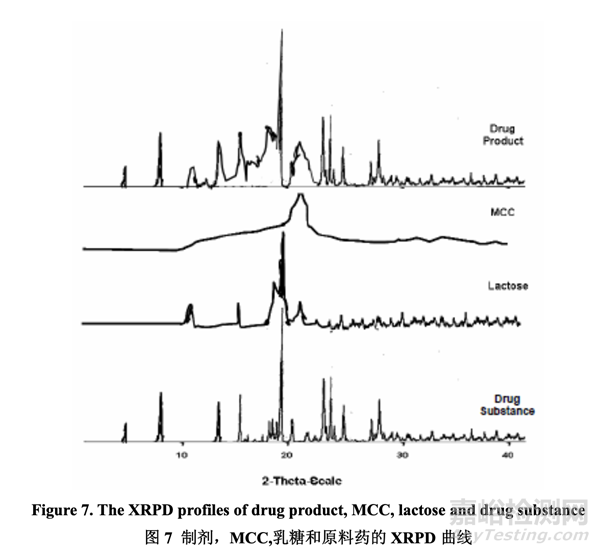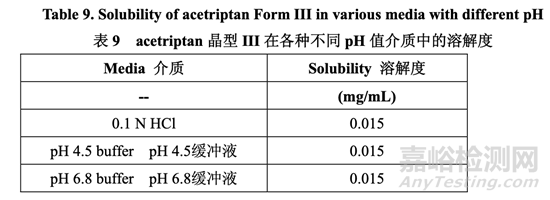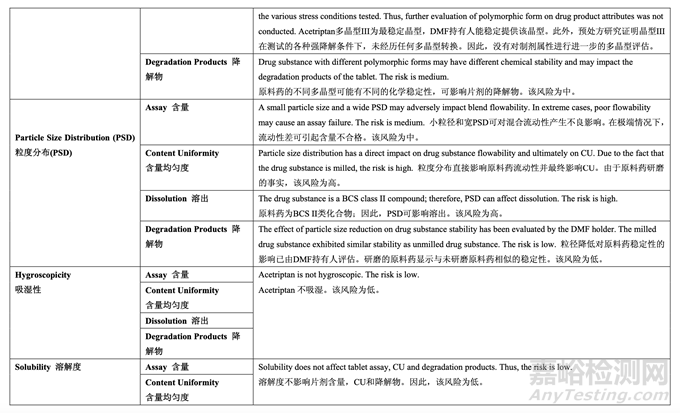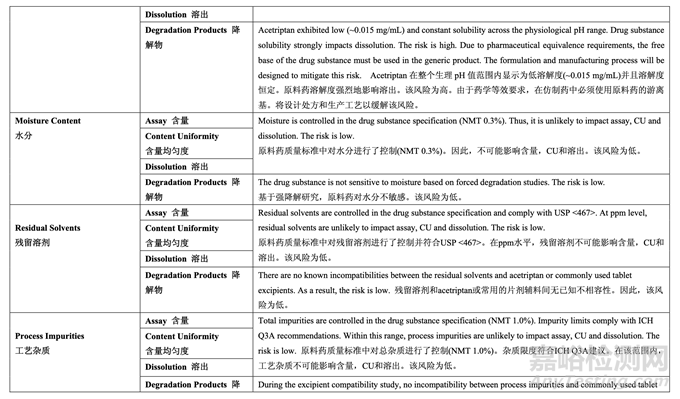This is an example pharmaceutical development report illustrating how ANDA applicants can move toward implementation of Quality by Design (QbD). The purpose of the example is to illustrate the types of pharmaceutical development studies ANDA applicants may use as they implement QbD in their generic product development and to promote discussion on how OGD would use this information in review.
FDA官网中一个有关药物开发报告的实例,用以说明申请人如何实施质量源于设计(QbD)。 该实例的目的是说明ANDA申请人在其仿制药开发过程中实施QbD时,可使用的药物开发研究的类型,同时促进探讨OGD在审评中如何使用该信息。
2.1 Components of Drug Product 制剂组分
2.1.1 Drug Substance 原料药
2.1.1.1 Physical Properties 物理性质 Physical description: 物理性状:
The following physical description is for acetriptan Form III. 如下物理性状适用于acetriptan III型。
Appearance: White to off-white, crystalline powder
外观:白色至类白色,结晶性粉末
Particle morphology: Plate-like crystals
粒子形态:板状晶体
Particle size distribution: PSD of drug substance Lot #2 was measured using Malvern Mastersizer. The results were as follows: d10 – 7.2 μm; d50 – 12 μm; d90 – 20 μm. This is representative of the drug substance PSD selected for the final drug product formulation.
粒度分布:使用Malvern Mastersizer粒度仪测量原料药批#2的PSD。结果如下:d10– 7.2 μm; d50 – 12 μm; d90 – 20 μm。这可代表选择用于最终药品处方的原料药 PSD。
Solid state form: 固态形式:
To date, three different crystalline forms (Form I, II and III) have been identified and reported in the literature. The three different forms were prepared using different solvents and crystallization conditions. The solubility and the melting point are different for each of the three polymorphs. Polymorphic Form III is the most stable form and has the highest melting point. The DMF holder provides acetriptan polymorphic Form III consistently based on in-house batch analysis data obtained by XRPD and DSC. Stress testing confirmed that no polymorphic conversion was observed (Table 10) and Form III is stable under the stress conditions of high temperatures, high humidity, UV light and mechanical stress. Since it is the most stable form, no phase transformation during the manufacturing process is expected. The Form III melting point and characteristic 2θ values are included in the drug substance specification as a part of the control strategy.
目前为止,已确定了3种不同晶型(I, II和III型)并报告在文献中。使用不同溶剂和结晶条件制备了3种不同晶型。3种多晶型物的每种溶解度和熔点都不相同。
多晶型III最稳定,熔点最高。 DMF持有人提供了稳定的acetriptan多晶型III,基于通过XRPD和DSC得到的内部批分析数据。强降解测试确认未观察到多晶型转换(表10),晶型III稳定在高温,高湿,UV光和机械 应力的强降解条件下保持稳定。因为这是最稳定的晶型,所以预期在生产工艺中无相变。晶型III的熔点和2θ值的特征包括在原料药质量标准中作为控制策略的一部分。
To confirm its physical stability, the final drug product was sampled during lab scale studies to evaluate whether processing conditions affected the polymorphic form of the drug substance. The XRPD data showed that the characteristics 2θ peaks of Form III of the drug substance are retained in the final drug product. Representative profiles are shown in Figure 7. An advanced XRPD technique was utilized to detect the possible phase transition in the drug product since the level of drug substance was 10% in the drug product.
为确认其物理稳定,在实验室规模研究中对最终药品取样以评估加工条件是否影响原料药的 多晶型。XRPD 数据表明原料药晶型 III 的 2θ 峰特征在最终药品中保持不变。代表性曲线见 图 7。使用一种先进的 XRPD 技术来检测药品中可能的相变,因为药品中原料药的浓度为 10%。
The most stable polymorph (Form III) exhibits plate-like morphology as shown in Figure 8.
最稳定的多晶型(III 型)显示板状形态,如图 8 所示。
Melting point: Approximately 186 °C (Form III)
熔点:约186 °C (III型)
Aqueous solubility as a function of pH: 随pH值而变的水性溶解度:The solubility of acetriptan Form III in aqueous media as a function of pH was measured and is presented in Table 9. The aqueous solubility of acetriptan is low (~0.015 mg/mL) and constant across the physiological pH range due to the lipophilic nature of the molecule.
测量了 acetriptan 晶型 III 在水性介质中随 pH 值而变的溶解度,见表 9。Acetriptan 的水性溶 解度低(~0.015 mg/mL),在整个生理 pH 值范围内恒定,由于分子的亲脂性。
Hygroscopicity: 吸湿性:
Acetriptan Form III is non-hygroscopic and requires no special protection from humidity during handling, shipping or storage. Hygroscopicity studies were carried out using a vapor sorption analyzer. The temperature was maintained at 25 °C. The material was exposed to stepwise increases in relative humidity from 10% to 90% for up to 150 minutes at each condition. The drug substance was non-hygroscopic, adsorbing less than 0.2% w/w at 90% RH.
Acetriptan晶型III为非吸湿,在处理,运输或贮存中不需要专门避湿。使用蒸汽吸附分析仪 进行了吸湿性研究。温度维持在25 °C。每种条件下,物料暴露于逐步增加的相对湿度(10%~ 90%)下达150分钟。原料药为非吸湿,在90% RH下吸附量低于0.2% w/w。
Density (Bulk, Tapped, and True) and Flowability: 密度(松密度,振实密度和真密度)和流动性:The bulk, tapped and true density as well as the flowability of acetriptan Form III (Lot #2 : d10 – 7.2 μm; d50 – 12 μm; d90 – 20 μm) were measured.
测量了acetriptan晶型III (批#2 : d10 – 7.2 μm; d50 – 12 μm; d90 – 20 μm)的松密度,振实密度 和真密度及流动性。
Bulk density: 0.27 g/cc Tapped density: 0.39 g/cc True density: 0.55 g/cc
松密度:0.27 g/cc 振实密度:0.39 g/cc
真密度:0.55 g/cc
The flow function coefficient (ffc) was 2.95 and the Hausner ratio was 1.44 which both indicate
poor flow properties. The cohesiveness of the drug substance was also studied using a powder rheometer. The specific energy (12 mJ/g) of the drug substance indicates that the drug substance is cohesive.
流动系数(ffc)为 2.95 和 Hausner 比为 1.44 都表明流动相差。同时使用粉末流动性测试仪研 究了原料药的内聚强度。原料药的比能(12 mJ/g)表明原料药具有粘性。
2.1.1.2 Chemical Properties 化学性质
pKa: Acetriptan is a weak base with a pKa of 9.2.
pKa: Acetriptan为弱碱,pKa值为9.2。
Chemical stability in solid state and in solution: 固态和溶液中的化学稳定性:
Stress testing (forced degradation) was carried out on acetriptan to study its impurity profile, degradation pathway and to facilitate the development of a stability-indicating method. In addition, knowledge obtained from the forced degradation studies was used during formulation and process design and development to prevent impurities from being generated. The specified stress conditions were intended to achieve approximately 5-20% degradation (if possible) of acetriptan or to represent a typical stress condition even though less than 5% degradation was achieved due to its inherent stability. The stressed samples were compared to the unstressed sample (control). Stress conditions and results are listed in Table 10 below.
对 acetriptan 进行了强降解测试以研究其杂质概况,降解路径并有助于开发一种指示稳定性 的方法。此外,从强降解研究中得到的知识在处方和工艺设计和开发中用于防止杂质产生。 规定的强降解条件目的是实现约 5~20%acetriptan 降解(如可能)或表示一种典型的强降解条件即使实现了不到 5%降解由于其内在稳定性。强降解样品与未强降解样品(对照)进行比较。 强降解条件和结果列于以下表 10 中。
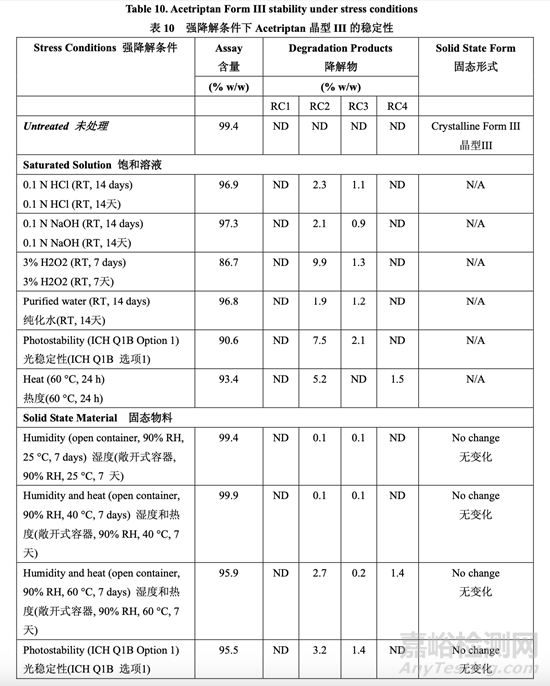
Samples were analyzed by HPLC equipped with a peak purity analyzer (photodiode array). Degradation peaks were well resolved from the main peak (acetriptan). The peak purity of the main peak and monitored degradants RC2 (ACE12345), RC3 (RRT = 0.68) and RC4 (RRT=0.79) were greater than 0.99. For each degradant, the peak purity angle was less than the peak purity threshold, suggesting that there was no interference of degradants with the main peak. Degradant RC1 was not observed. Degradant RC2 was formed due to oxidation and degradant RC3 was the result of further oxidation. Based on the results of the forced degradation studies, RC2 and RC3 were identified as the principal degradation products under the stress conditions. RC3 was not found under long-term stability conditions. With prolonged exposure to excessive high temperature (105 oC, 96 hours), 14% of RC4 was observed.
通过装备峰纯度分析仪(光电二极管阵列)的HPLC分析样品。降解峰与主峰(acetriptan)分离良 好。主峰和监测降解物RC2 (ACE12345), RC3 (RRT = 0.68)及RC4 (RRT=0.79)的峰纯度都大 于0.99。对于每种降解物,峰纯度角低于峰纯度阈值,表明降解物对主峰不产生干扰。未观 察到降解物RC1。形成降解物RC2由于氧化作用,降解物RC3是进一步氧化作用的结果。基于强降解研究的结果,确定RC2和RC3为强降解条件下的主要降解物。长期稳定性条件下未发现RC3。长时间暴露于过高温度下(105 oC, 96小时),观察到14%的RC4。
Overall, acetriptan is susceptible to dry heat, UV light and oxidative degradation. 总之,acetriptan 对干热,UV 光和氧化降解敏感。
2.1.1.3 Biological Properties 生物学性质
Partition coefficient: Log P 3.55 (25 °C, pH 6.8) 分配系数:Log P 3.55 (25 °C, pH 6.8) Caco-2 permeability: 34 × 10-6 cm/s Caco-2 渗透性:34 × 10-6 cm/s
The Caco-2 permeability is higher than the reference standard, metoprolol, which has a Caco-2 permeability of 20 × 10-6 cm/s. Therefore, acetriptan is highly permeable. Caco-2渗透性高于对照品,美托洛尔,其Caco-2渗透性为20 × 10-6 cm/s。因此,acetriptan为 高渗透性。
Biopharmaceutics Classification: 生物药剂学分类:
Literature and in-house experimental data support the categorization of acetriptan as a highly permeable drug substance. Based on its solubility across physiological pH (Table 9) acetriptan is designated as a low solubility drug substance. The calculated dose solubility volume is as follows: 文献和内部实验数据支持acetriptan归为高渗透性药物。基于其在整个生理pH内的溶解度(表 9),指定acetriptan为低溶解度药物。计算的剂量溶解度体积如下:
20 mg (highest strength)/(0.015 mg/mL) = 1333 mL > 250 mL
20 mg (最高规格)/(0.015 mg/mL) = 1333 mL > 250 mL
Therefore, acetriptan is considered a BCS Class II compound (low solubility and high permeability) according to the BCS guidance.
因此,根据BCS指南,acetriptan被视为BCS II类化合物(低溶解度和高渗透性)。2.1.1.4 Risk Assessment of Drug Substance Attributes 原料药属性的风险评估
A risk assessment of the drug substance attributes was performed to evaluate the impact that each attribute could have on the drug product CQAs. The outcome of the assessment and the accompanying justification is provided as a summary in the pharmaceutical development report. The relative risk that each attribute presents was ranked as high, medium or low. The high risk attributes warranted further investigation whereas the low risk attributes required no further investigation. The medium risk is considered acceptable based on current knowledge. Further investigation for medium risk may be needed in order to reduce the risk. The same relative risk ranking system was used throughout pharmaceutical development and is summarized in Table 11. For each risk assessment performed, the rationale for the risk assessment tool selection and the details of the risk identification, analysis and evaluation are available to the FDA Reviewer upon request.
进行原料药属性的风险评估以评估每种属性可能对制剂 CQAs 的影响。评估结果和伴随的依 据以总结方式提供于药物开发报告中。每个属性显示的相对风险以高,中或低排列。高风险属性需进一步的研究,而低风险属性无需进一步的研究。基于现在的知识,中风险视为可接 受。可能需要进一步研究中风险以便降低风险。整个药物开发中使用相同的相对风险排序系 统,并总结在表 11 中。对于进行的每个风险评估,选择风险评估工具的理由和详细鉴别, 分析和评估风险见 FDA 基于要求的审查。
Note to Reader: According to ICH Q9 Quality Risk Management, it is important to note that “it is neither always appropriate nor always necessary to use a formal risk management process (using recognized tools and/or internal procedures e.g., standard operating procedures). The use of informal risk management processes (using empirical tools and/or internal procedures) can also be considered acceptable. Appropriate use of quality risk management can facilitate but does not obviate industry’s obligation to comply with regulatory requirements and does not replace appropriate communications between industry and regulators.”4
致读者:按照 ICH Q9 质量风险管理,重要的是注意”使用正式的风险管理过程(使用认可的 方法和/或内部程序例如标准操作程序) 并非总是合适的或必要的。使用非正式的风险管理 过程(使用经验方法和/或内部程序) 也可被视为可接受。质量风险管理的适当使用可有助于 但不能排除遵守法规要求的行业义务,也不能取代行业和监管机构间的适宜沟通。“4
The two primary principles should be considered when implementing quality risk management:
实施质量风险管理时应考虑两个主要原则:
• The evaluation of the risk to quality should be based on scientific knowledge and ultimately link to the protection of the patient; and
质量风险的评估应基于科学知识并最终与保护患者相联系;而且
• The level of effort, formality and documentation of the quality risk management process should be commensurate with the level of risk.
质量风险管理过程中投入的努力程度、管理的正式程度及文件管理水平应与风险水平相适应。
Based upon the physicochemical and biological properties of the drug substance, the initial risk assessment of drug substance attributes on drug product CQAs is shown in Table 12. 基于原料药的理化和生物学性质,原料药属性对制剂 CQAs 的初始风险评估见表 12。
2.1.2 Excipients 辅料
The excipients used in acetriptan tablets were selected based on the excipients used in the RLD, excipient compatibility studies and prior use in approved ANDA products that utilize roller compaction (RC). A summary of the excipient-drug substance compatibility studies and the selection of each excipient grade is provided in the following section.
选择acetriptan片中使用的辅料是基于RLD中使用的辅料,辅料相容性研究和先用于已批准的 使用碾压(RC)的ANDA产品中。辅料-原料药相容性研究和每种辅料级别的选择总结见下节。
2.1.2.1 Excipient Compatibility Studies 辅料相容性研究
Note to Reader: Excipient compatibility is an important part of understanding the role of inactive ingredients in product quality. The selection of excipients for the compatibility study should be based on the mechanistic understanding of the drug substance and its impurities, excipients and their impurities, degradation pathway and potential processing conditions for the drug product manufacture. A scientifically sound approach should be used in constructing the compatibility studies. The commercial grades of the excipients are not provided in this example to avoid endorsement of specific products. However, in an actual pharmaceutical development report, the names of the commercial grades are expected.
辅料相容性是理解非活性成分在产品质量中作用的重要部分。对于相容性研究的辅 料选择应基于理解原料药和其杂质,辅料和其杂质,制剂生产的降解路径和潜在加工条件的 机理。科学合理的方法应用于构造相容性研究中。该实例中不提供市售级的辅料以避免为某 些特定产品代言。但是,在实际药物开发报告中,可预期市售级的名称。
Excipient-drug substance compatibility was assessed through HPLC analysis of binary mixtures of excipient and drug substance at a 1:1 ratio in the solid state. Samples were stored at 25 °C/60 % RH and 40 °C/75 % RH in both open and closed containers for 1 month. Common excipients functioning as filler, disintegrant, and lubricant were evaluated in the excipient compatibility study. Table 14 summarizes the results.
通过 HPLC 分析固态下辅料与原料药以 1:1 比例的二元混合物,来评估辅料-原料药的相容 性。敞口容器和密封容器中的样品贮存在 25 °C/60 % RH 和 40 °C/75 % RH 下各 1 个月。辅 料相容性研究中评估作用为填充剂,崩解剂和润滑剂的普通辅料。表 14 总结了结果。


Loss in assay or detection of degradants indicative of an incompatibility was not observed for the selected excipients except magnesium stearate. An interaction was seen with magnesium stearate at 40 °C/75 % RH. This interaction caused lower assay results for acetriptan. The mechanism for this interaction was indentified as formation of a magnesium stearate-acetriptan adduct (AD1) involving stearic acid. To further evaluate if this potential interaction could cause drug instability, an additional experiment was performed in which several different mixtures of drug and excipients were prepared. Only the excipient types used in the RLD formulation were selected for this study. The first mixture consisted of drug and all excipients in the ratio representative of the finished product. In subsequent mixtures, one excipient was removed at a time. These mixtures were stored at 25 °C/60% RH and 40 °C/75% RH in both open and closed containers for 1 month. Table 15 presents the results of the study.
对于所选的辅料除硬脂酸镁外,未观察到表示不相容性的含量损失或检测到降解物。在 40 °C/75 % RH 下,观察到与硬脂酸镁的相互作用。该相互作用引起 acetriptan 含量结果较低。 该相互作用的机理确定为形成一种包括硬脂酸的硬脂酸镁- acetriptan加合物(AD1)。为进一 步评估该潜在相互作用是否可引起药物不稳定,进行了一额外实验,制备了药物和辅料的几 种不同混合物。该研究仅选择 RLD 处方中使用的辅料类型。第一种混合物包括代表成品比 例的药物和所有辅料。在随后的混合物中,每次去掉一种辅料。在 25 °C/60 % RH 和 40 °C/75 % RH 下,这些混合物贮存在敞口容器和密封容器中各 1 个月。研究的结果见表 15。
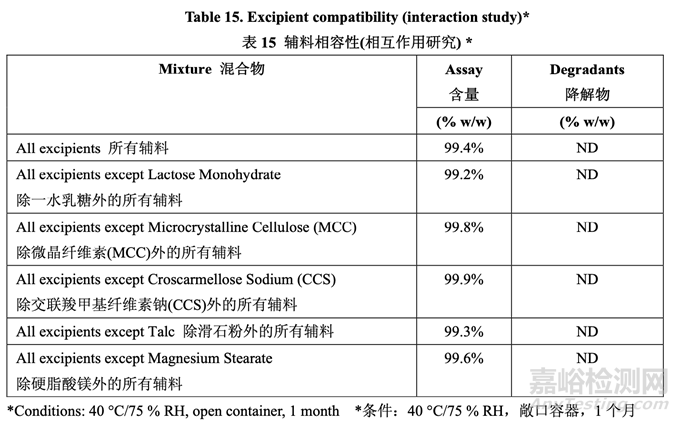
No loss in assay was observed in any of these mixtures at 40 °C/75% RH or at 25 °C/60% RH. There is no incompatibility with the selected excipients except for the noted interaction with magnesium stearate in the binary mixture study. Therefore, magnesium stearate was still selected, but contact of the drug substance with magnesium stearate was limited by only using extragranular magnesium stearate. Intragranular lubrication required for the roller compaction process was achieved by using talc. Subsequent assurance of compatibility was provided by long-term stability data for formulations used in the pilot BE study and the ongoing prototype stability studies using the formulation proposed for commercialization. The impurity method is able to identify and quantify AD1. Adduct formation was below the limit of quantitation in the long-term stability study and is controlled by the limit for any unspecified impurity.
在40 °C/75% RH 或25 °C/60%RH下,在这些混合物中的任意一种未观察到含量损失。在二 元混合物研究中,除注意到与硬脂酸镁相互作用外,与所选辅料无不相容性。因此,仍然选 择硬脂酸镁,但是通过仅使用外加硬脂酸镁来限制原料药与硬脂酸镁的接触。通过使用滑石 粉来实现碾压所需的颗粒内润滑。随后通过提供用于中试BE研究的处方的长期稳定性数据 和正在进行的,使用拟定用于工业化的处方的原型稳定性研究来保证相容性。杂质方法能鉴 定和定量AD1。长期稳定性研究中形成的加合物低于定量限,通过该限度来控制任何未指定杂质。
2.1.2.2 Excipient Grade Selection 辅料级别选择
Based on the results of excipient compatibility studies, identical excipient types to the RLD formulation were selected for the generic product development. The selection of excipient grade and supplier was based on previous formulation experience and knowledge about excipients that have been used successfully in approved products manufactured by roller compaction as given in Table 16. The level of excipients used in the formulation were studied in subsequent formulation development studies.
基于辅料相容性研究的结果,选择与 RLD 处方相同的辅料类型用于仿制药开发。辅料级别 和供应商的选择是基于之前的处方经验和关于已成功地用于已批准的通过碾压生产的药品 中的辅料的知识,如表 16 所示。处方中使用的辅料浓度在随后的处方开发研究中进行研究。
Microcrystalline cellulose and lactose monohydrate comprise about 80% of the total drug product composition. Microcrystalline cellulose and lactose monohydrate are among the commonly used fillers for dry granulation formulations, both individually and in combination with each other, because they exhibit appropriate flow and compression properties. The particle size distribution, particle morphology, aspect ratio, bulk density and flowability of different grades have the potential to affect drug product content uniformity. Therefore, additional particle size controls above those in the pharmacopoeia are included in the specifications for the two major excipients: lactose monohydrate (d50: 70-100 μm) and microcrystalline cellulose (d50: 80-140 μm). Material within these ranges was used in all further formulation studies.
微晶纤维素和一水乳糖构成约80%的总制剂组分。微晶纤维素和一水乳糖是属于普遍用于干 法制粒处方中使用的填充剂,可单独使用及互相一起使用,因为它们显示出适宜的流动性和 压缩性。不同级别的粒度分布,粒子形态,纵横比,松密度和流动性可潜在影响制剂含量均 匀度。因此,对于两种主要辅料,除药典规定外,质量标准中包括了额外粒径控制:一水乳 糖(d50:70~100 μm)和微晶纤维素(d50:80~140 μm)。在所有进一步的处方研究中使用在 这些范围内的物料。
Lactose Monohydrate: Lactose monohydrate is commonly used as a filler. The potential impurities of lactose are melamine and aldehydes. The supplier has certified that the lactose is free of melamine and has provided a certificate of suitability for TSE/BSE. Lactose monohydrate Grade A01 from supplier A was selected based on successful product development in approved ANDA 123456 and ANDA 456123, both of which used roller compaction. The selected grade provides acceptable flow and compression properties when used in combination with microcrystalline cellulose.
一水乳糖:一水乳糖普遍作为填充剂使用。乳糖的潜在杂质是三聚氰胺和醛。供应商证明该 乳糖不含三聚氰胺并提供了 TSE/BSE 的适用性证明。基于在已批准都使用碾压的 ANDA 123456 和 ANDA 456123 中成功的产品开发,选择供应商 A,级别 A01 的一水乳糖。所选 的级别提供了可接受的流动性和压缩性当与微晶纤维素联合使用时。
Microcrystalline Cellulose (MCC): Microcrystalline cellulose is widely used as a filler for direct compression and roller compaction. Though it is reported in the literature that MCC may
physically bind or adsorb drug substance, no such physical interaction was evident in the formulation dissolution studies. It is known from the literature that MCC undergoes plastic deformation during compaction since it is a fibrous material and ductile in nature. Not all grades of MCC may be suitable for use in roller compaction. Microcrystalline cellulose Grade B02 from supplier B was selected based on the acceptable flow and compression properties when used in combination with lactose monohydrate as demonstrated in approved ANDA 123456 and ANDA 456123.
微晶纤维素(MCC):微晶纤维素广泛作为直压和碾压的填充剂使用。虽然有文献报告MCC 可实际粘合或吸附原料药,但是在处方溶出研究中,此类物理相互作用不显著。从文献上可 知MCC在压缩中经历了塑性变形因为它是纤维材料,本质上具有可塑性。不是所有级别的 MCC可适用于在碾压中使用。基于当与一水乳糖联合使用时的可接受流动性和压缩性,如 已批准的ANDA 123456 和ANDA 456123所示,选择供应商B,级别B02的微晶纤维素。
Croscarmellose Sodium (CCS): Acetriptan is a BCS class II drug so rapid disintegration is necessary to ensure maximum bioavailability. Being a superdisintegrant, croscarmellose sodium is hygroscopic in nature. It swells rapidly to about 4-8 times its original volume when it comes in contact with water. Grade C03 from supplier C was selected. 交联羧甲基纤维素钠(CCS):Acetriptan为BCS II类药物,因此需要快速崩解以保证生物利用 度最大化。作为一种超级崩解剂,交联羧甲基纤维素钠本质上具有吸湿性。当它接触到水时, 膨胀至其原体积的约4~8倍。选择供应商C的级别C03。
Talc: Talc is a common metamorphic mineral and is used as a glidant and/or lubricant both intragranularly and extragranularly in the formulation. Intragranular talc was used to prevent sticking during the roller compaction process. Because of the interaction between magnesium stearate and acetriptan, talc was also added extragranularly to reduce the level of magnesium stearate needed for the lubrication. Grade D04 from supplier D was selected.
滑石粉:滑石粉是普通的变质矿物,在处方中作为内加和外加助流剂和/或润滑剂使用。内 加滑石粉用于防止碾压工艺中发生粘结。因为硬脂酸镁和acetriptan间的相互作用,也以外加 方式加入滑石粉以降低润滑所需的硬脂酸镁浓度。选择供应商D的级别D04。
Magnesium Stearate: It is the most commonly used lubricant for tablets. Because magnesium stearate interacts with acetriptan to form an adduct, it is used only extragranularly. Magnesium stearate grade E05 from supplier E was selected and is of vegetable origin.
硬脂酸镁:普遍作为片剂的润滑剂使用。因为硬脂酸镁和 acetriptan 间的相互作用可形成加 合物,所以仅以外加方式使用。选择供应商 E,级别 E05,来自植物源的硬脂酸镁。
参考文献:
Example QbD IR Tablet Module 3 Quality 3.2.P.2 Pharmaceutical Development,FDA,2012.

